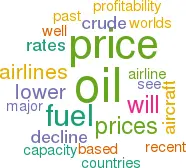Fuel: Optimistic glow
November 2014


Having got used to the idea of oil prices well above $100/bbl it comes as a bit of a shock when the spot price of the commodity falls by 50% as it has done in the past six months. A short term bonanza? Or signs of something more serious?
In the recent OPEC meeting in Vienna the oil producers' cartel agreed not (or failed to agree) to reduce oil production to shore up the price on the world's markets. At the same time, the US announced a further increase in crude inventories, as its fracking ventures allow it to move further towards self-sufficiency as the world's largest consumer of crude oil. The conspiracy theory is that OPEC is allowing a softening in the oil price in order to undermine the economics of fracking, but the member states recognise that they cannot exert much influence on long-term extraction trends.
Oil analysts are now suggesting that the crude price could stabilise at around $60/bbl, a level last seen in 2006, clearly enhancing GDP growth in consuming countries, by 0.5 to 1.5 percentage points. For the airline industry, this would imply a Jet A price of around $2/US gallon, depending on local cracking margins, whereas most airlines had been until recently planning on about $3/gallon.
Using IATA’s fuel calculator, the global fuel bill should be reduced by about $9bn on an annualised basis compared to the 2013 level. As IATA’s net profit forecast for 2014 was $18bn, this development would appear to be a major boost to the industry.
Yet one idea being promulgated within the financial community — particularly in the US — suggests that lower oil prices could be negative for airlines. The argument appears to be that the lower the oil price the more likely that airlines would increase capacity and therefore undermine the capacity discipline that the consolidated US industry is enjoying.
This outlook seems unlikely. Both network and low cost carriers in North America and, to a large extent, Europe have based their recent strategies on restrained capacity growth with the primary aim of pushing up unit revenues. This in turn has translated into higher profitability and, for most major airlines, substantial increases in stockmarket valuations. The decline in fuel prices will be seen as a further opportunity to boost profitability (unless hedging policies have backfired). Also, there is even less chance that increased profitability will provoke labour disputes in the US — ALPA over the past 2-3 years has negotiated agreements whereby approximately 15% of salaries vary according to airline profitability,
However, the situation may be somewhat different in Asia and South America. There, the emergent low-cost carrier are still in the stage of expanding their networks and the lower fuel price might well be used as an opportunity for attempting to gain market share.
The oil price decline could be regarded as negative for the Gulf-located Super-Connectors (and beneficial for the Euro-Majors). But this development may be a vindication of their national strategies: moving away from dependence on carbon extraction from depleting oil fields to building economies based on services, tourism and transport.
At the current Brent crude price of $71, a recent study by Deutsche Bank estimates that most of the world's major oil producers will have a national budget deficit (see chart). But Emirates will not be affected as Dubai has limited oil production and the airline is commercially and successfully run; THY will benefit from lower fuel prices; Qatar and Abu Dhabi have immense gas reserves as well as financial security, so it is difficult to see their airlines being directly impacted. (What happens when Etihad’s investments unravel is another story).
How will the new fuel price impact aircraft values? As Paul Leighton of AVAC, the leading aircraft appraiser, notes, “operators cannot make long term fleet planning decisions based on short-term oil price fluctuations”. While lower fuel prices in the past have tended to raise demand for older jets relative to modern, fuel-efficient types, this equation no longer quite works. Many countries have formal or informal age limits on the age of aircraft that can be imported or leased; 15 years in African and Asian countries, in Russia and former USSR states, a 10 year limit. AVAC raises the possibility that “middle-aged” aircraft — 10 year old A320s, 737s, 767s and A330s might benefit.
As for operating lease rates, which according to the consensus opinion at the October ISTAT conference have peaked (see next pages for current rates) the oil price decline implies a high plateau rather than a decline — as oil prices reduce inflationary pressures, in turn moderating interest rates which then feed into operating lease rates.